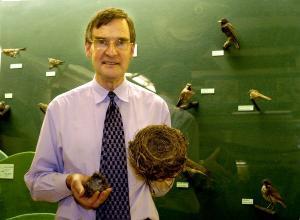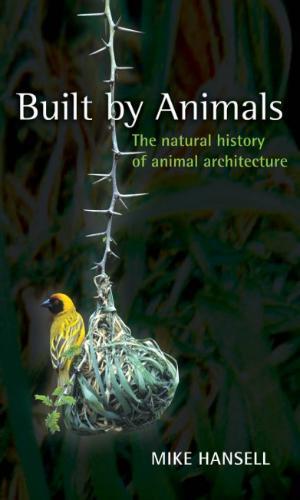Honorary Professor Mike H Hansell
Honorary Professor Mike H Hansell
Emeritus Professor of Animal Architecture
Contact details:
Room 323, Graham Kerr Building
Institute of Biodiversity, Animal Health & Comparative Medicine
College of Medical, Veterinary & Life Sciences
University of GlasgowUniversity of Glasgow
Glasgow
G12 8QQ
Tel.: 0141 330 4779
Fax: 0141 330 5971
E-mail: Mike.Hansell@glasgow.ac.uk
Research Interests
Research Interests
 Any creature that builds anything, and I want to know the nature of the built structure and how the animal builds it. I have conducted research on the building behaviour of animals of various kinds: - in particular on the nest building of birds and wasps and on the case building of caddis fly larvae. However, my interest now is not so much on individual species as on making sense of the biology of animal building. This viewpoint embraces the whole range of animal builders to obtain a better understanding of the evolution of animal building behaviour, its ecological consequences and the complexity or simplicity of the behaviour itself.
Any creature that builds anything, and I want to know the nature of the built structure and how the animal builds it. I have conducted research on the building behaviour of animals of various kinds: - in particular on the nest building of birds and wasps and on the case building of caddis fly larvae. However, my interest now is not so much on individual species as on making sense of the biology of animal building. This viewpoint embraces the whole range of animal builders to obtain a better understanding of the evolution of animal building behaviour, its ecological consequences and the complexity or simplicity of the behaviour itself.
Academic history
Academic history
- Current Emeritus Professor of Animal Architecture, Honorary Senior Research Fellow, University of Glasgow
- 2005- Professor of Animal Architecture, University of Glasgow
- 1985-2005 Senior Lecturer, University of Glasgow
- 1971-85 Lecturer, University of Glasgow
- 1968-71 Assistant Lecturer, University of Glasgow
- 1966-68 Lecturer in Zoology, University of Khartoum
Selected Publications
Selected Publications
 Books
Books
Hansell, M. 2007. Built by Animals. Oxford University Press, Oxford pp256.
(ISBN - 978-0-19-920556-11)
Hansell, M.H. 2005. Animal Architecture. Oxford University Press, Oxford pp 321.
(ISBN 0-19-850752-6)
Hansell, M. 2000. Bird Nests and Construction Behaviour. Cambridge University Press, Cambridge pp. 280. (ISBN 0-521-460387)
Hansell, M. 2000. Animal Behaviour Student Monograph (Advanced Higher) Learning and Teaching Scotland pp 67. (ISBN 1-85955-877-1)
Hansell, M.H., Reilly,, M. & Perry, S. 1999. The Animal Construction Company. Glasgow University, Hunterian Museum and Art Gallery pp 112. (ISBN 0-904254-69-0).
Research Papers
Hansell, M.H., Ruxton, G.D. & Ennos, R. 2014. Collected and self-secreted building materials and their contribution to compression and tension structures. Biological Journal of the Linnean Society 122, 625-639.
Walsh, P., Hansell, M., Borello, W.D. & Healy, S.D. 2013. Are elaborate nests built using simple rules? Avian Biology Research 6 (2) 157-162.
Russell, D.G.D., Hansell, M. & Reilly, M. 2013. Bird nests in museum collections: a rich source for research. Avian Biology Research 6 (2) 178-182
Hansell, M.H. & Ruxton, G.D. 2013. Exploring the dichotomy between animals building using self-secreted materials and using materials collected from the environment. Biological Journal of the Linnean Society 108 (3), 688-701.
Hansell, M.H. 2011. Houses made by protists. (Quick Guides). Current Biology 21 (13), R485-R487.
Ruxton, G.D. & Hansell, M.H. 2011. Fishing with a bait or lure: a brief review of the cognitive issues. Ethology 117, 1-9.
Walsh, P.T., Hansell, M., Borello, W.D. & Healy, S.D. 2011. Individuality in nest building: Do southern masked weavers (Ploceus velatus) males vary in their nest building behaviour? Behavioural Processes 88, 1-6.
Hansell, M. & Ruxton, G.D. 2008. Setting tool use in the context of animal construction and behaviour. Trends in Ecology and Evolution 23:73-78.
Stewart, F.A, Pruetz, J.D. & Hansell, M.H. 2007. Do chimpanzees build comfortable nests? American Journal of Primatology 69: 930-939.
Grants
Grants
2008-2011 Cognitive basis of nest building in birds.
Principal investigators:
Dr Sue Healy, Institute of Evolutionary Biology, University of Edinburgh
Prof Mike Hansell, Institute of Biomedical and Life Sciences, University of Glasgow
Funded by the Leverhulme Trust
Other information
Other information
The National Nest Reference Collection
This is a collection of the nests of British breeding birds. I began this collection in 1998 and soon after, it was incorporated into the University of Glasgow, Hunterian Museum Zoological Collection. It now has over 1,500 specimens representing about 90 species and, as such, is one of the largest museum collections in Europe and unique in Europe for aiming to represent within-species as well as between-species differences.

